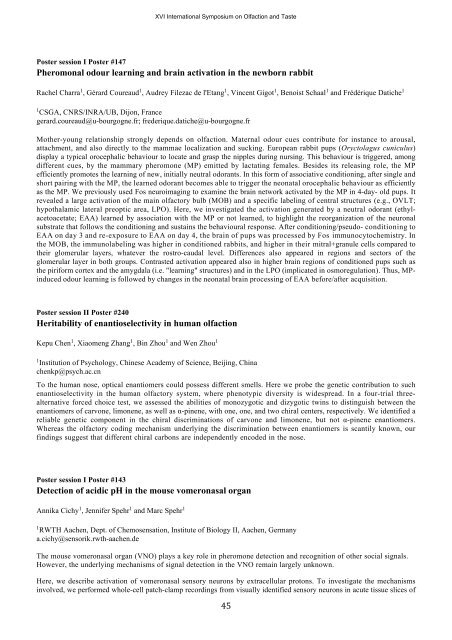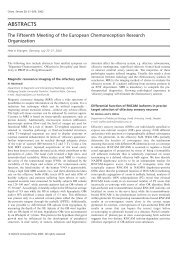XVI International Symposium on Olfaction and Taste - ecro
XVI International Symposium on Olfaction and Taste - ecro
XVI International Symposium on Olfaction and Taste - ecro
Create successful ePaper yourself
Turn your PDF publications into a flip-book with our unique Google optimized e-Paper software.
<str<strong>on</strong>g>XVI</str<strong>on</strong>g> <str<strong>on</strong>g>Internati<strong>on</strong>al</str<strong>on</strong>g> <str<strong>on</strong>g>Symposium</str<strong>on</strong>g> <strong>on</strong> Olfacti<strong>on</strong> <strong>and</strong> <strong>Taste</strong><br />
Poster sessi<strong>on</strong> I Poster #147<br />
Pherom<strong>on</strong>al odour learning <strong>and</strong> brain activati<strong>on</strong> in the newborn rabbit<br />
Rachel Charra 1 , Gérard Coureaud 1 , Audrey Filezac de l'Etang 1 , Vincent Gigot 1 , Benoist Schaal 1 <strong>and</strong> Frédérique Datiche 1<br />
1 CSGA, CNRS/INRA/UB, Dij<strong>on</strong>, France<br />
gerard.coureaud@u-bourgogne.fr; frederique.datiche@u-bourgogne.fr<br />
Mother-young relati<strong>on</strong>ship str<strong>on</strong>gly depends <strong>on</strong> olfacti<strong>on</strong>. Maternal odour cues c<strong>on</strong>tribute for instance to arousal,<br />
attachment, <strong>and</strong> also directly to the mammae localizati<strong>on</strong> <strong>and</strong> sucking. European rabbit pups (Oryctolagus cuniculus)<br />
display a typical orocephalic behaviour to locate <strong>and</strong> grasp the nipples during nursing. This behaviour is triggered, am<strong>on</strong>g<br />
different cues, by the mammary pherom<strong>on</strong>e (MP) emitted by lactating females. Besides its releasing role, the MP<br />
efficiently promotes the learning of new, initially neutral odorants. In this form of associative c<strong>on</strong>diti<strong>on</strong>ing, after single <strong>and</strong><br />
short pairing with the MP, the learned odorant becomes able to trigger the ne<strong>on</strong>atal orocephalic behaviour as efficiently<br />
as the MP. We previously used Fos neuroimaging to examine the brain network activated by the MP in 4-day- old pups. It<br />
revealed a large activati<strong>on</strong> of the main olfactory bulb (MOB) <strong>and</strong> a specific labeling of central structures (e.g., OVLT;<br />
hypothalamic lateral preoptic area, LPO). Here, we investigated the activati<strong>on</strong> generated by a neutral odorant (ethylacetoacetate;<br />
EAA) learned by associati<strong>on</strong> with the MP or not learned, to highlight the reorganizati<strong>on</strong> of the neur<strong>on</strong>al<br />
substrate that follows the c<strong>on</strong>diti<strong>on</strong>ing <strong>and</strong> sustains the behavioural resp<strong>on</strong>se. After c<strong>on</strong>diti<strong>on</strong>ing/pseudo- c<strong>on</strong>diti<strong>on</strong>ing to<br />
EAA <strong>on</strong> day 3 <strong>and</strong> re-exposure to EAA <strong>on</strong> day 4, the brain of pups was processed by Fos immunocytochemistry. In<br />
the MOB, the immunolabeling was higher in c<strong>on</strong>diti<strong>on</strong>ed rabbits, <strong>and</strong> higher in their mitral+granule cells compared to<br />
their glomerular layers, whatever the rostro-caudal level. Differences also appeared in regi<strong>on</strong>s <strong>and</strong> sectors of the<br />
glomerular layer in both groups. C<strong>on</strong>trasted activati<strong>on</strong> appeared also in higher brain regi<strong>on</strong>s of c<strong>on</strong>diti<strong>on</strong>ed pups such as<br />
the piriform cortex <strong>and</strong> the amygdala (i.e. "learning" structures) <strong>and</strong> in the LPO (implicated in osmoregulati<strong>on</strong>). Thus, MPinduced<br />
odour learning is followed by changes in the ne<strong>on</strong>atal brain processing of EAA before/after acquisiti<strong>on</strong>.<br />
Poster sessi<strong>on</strong> II Poster #240<br />
Heritability of enantioselectivity in human olfacti<strong>on</strong><br />
Kepu Chen 1 , Xiaomeng Zhang 1 , Bin Zhou 1 <strong>and</strong> Wen Zhou 1<br />
1Instituti<strong>on</strong> of Psychology, Chinese Academy of Science, Beijing, China<br />
chenkp@psych.ac.cn<br />
To the human nose, optical enantiomers could possess different smells. Here we probe the genetic c<strong>on</strong>tributi<strong>on</strong> to such<br />
enantioselectivity in the human olfactory system, where phenotypic diversity is widespread. In a four-trial three-<br />
alternative forced choice test, we assessed the abilities of m<strong>on</strong>ozygotic <strong>and</strong> dizygotic twins to distinguish between the<br />
enantiomers of carv<strong>on</strong>e, lim<strong>on</strong>ene, as well as α-pinene, with <strong>on</strong>e, <strong>on</strong>e, <strong>and</strong> two chiral centers, respectively. We identified a<br />
reliable genetic comp<strong>on</strong>ent in the chiral discriminati<strong>on</strong>s of carv<strong>on</strong>e <strong>and</strong> lim<strong>on</strong>ene, but not α-pinene enantiomers.<br />
Whereas the olfactory coding mechanism underlying the discriminati<strong>on</strong> between enantiomers is scantily known, our<br />
findings suggest that different chiral carb<strong>on</strong>s are independently encoded in the nose.<br />
Poster sessi<strong>on</strong> I Poster #143<br />
Detecti<strong>on</strong> of acidic pH in the mouse vomer<strong>on</strong>asal organ<br />
Annika Cichy 1 , Jennifer Spehr 1 <strong>and</strong> Marc Spehr 1<br />
1 RWTH Aachen, Dept. of Chemosensati<strong>on</strong>, Institute of Biology II, Aachen, Germany<br />
a.cichy@sensorik.rwth-aachen.de<br />
The mouse vomer<strong>on</strong>asal organ (VNO) plays a key role in pherom<strong>on</strong>e detecti<strong>on</strong> <strong>and</strong> recogniti<strong>on</strong> of other social signals.<br />
However, the underlying mechanisms of signal detecti<strong>on</strong> in the VNO remain largely unknown.<br />
Here, we describe activati<strong>on</strong> of vomer<strong>on</strong>asal sensory neur<strong>on</strong>s by extracellular prot<strong>on</strong>s. To investigate the mechanisms<br />
involved, we performed whole-cell patch-clamp recordings from visually identified sensory neur<strong>on</strong>s in acute tissue slices of<br />
45



